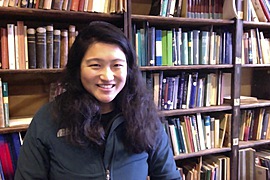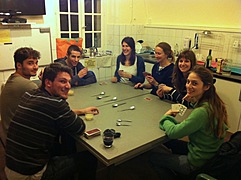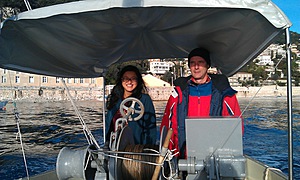Five weeks in Villefranche
by Jessica Luo, PhD Candidate, on
I would like to thank the faculty, students and staff of the Ocean Observatory of Villefranche for the opportunity to study and work at the Lab for five weeks, particularly the instructors of the Exploratory Multidimensional Analysis in Environment (AME2) course, Jean-Olivier Irisson, Sakina-Dorothée Ayata, and Stéphane Gasparini, as well as the numerous other scientists I had the pleasure of interacting with: Marc Picheral, Fabien Lombard, Lars Stemmann, Martin Lilley and Robin Faillettaz.
I stayed at the Lab between January 7 and February 9, 2013. During the first three weeks, I took the AME2 course, which covered topics such as constrained and unconstrained ordination, time series, clustering, and discriminant analyses. The course mostly utilized the statistical programming language R, but also other statistical programs such as TANAGRA, PATH and SYSTAT. The unofficial textbook for the course was Legendre and Legendre’s Numerical Ecology (1998 and 2013). Like Erica and Dan commented, the three week course structure is very intensive, but taught extremely well. I appreciated the opportunity to be completely immersed in the subject matter, to learn useful techniques that are not commonly taught in the US (e.g. correspondence analysis), and the introduction and experience working with R. For me, the class was most valuable as a broad introduction to multivariate statistics that gave me the tools to delve more deeply into other specialized and derivative methods, many of which are based on these core statistical tools (PCA, CA, RDA, etc). Being able to now decipher Legendre and Legrendre’s Numerical Ecology is alone worth the three weeks of class, not to mention all the programming tools that we learned.
The crème de la crème of my stay was actually the two weeks following, in which I stayed at Oceanography Lab of Villefranche (LOV) to work with Jean-Olivier Irisson and applied the techniques and tools I learned from the course to start analyzing data for my PhD. At the same time, I also worked with Marc Picheral to learn how to use ZooProcess, a program designed to process and analyze in situ images of plankton, and evaluate how well ZooProcess could be used on data from the In Situ Ichthyoplankton Imaging System (ISIIS), an imaging tool I am using for my dissertation. This was a very productive time for me, and I especially enjoyed the exchange of ideas, perspectives and expertise with the scientists in the LOV plankton team, many of whom work on topics similar to my research interests.
Villefranche-sur-Mer is a beautiful place to be in the wintertime, and in my free time, I enjoyed visiting Nice, the Southern Alps, Monaco and running along the hilly and stunning coastline of the Côte d’Azur.
I am looking forward to this continued partnership between the two institutions and hope that the exchange of students, researchers and faculty will lead to many more productive and enriching collaborations. Thank you to PUF for this funding opportunity and especially to Jean-Olivier Irisson for his time.


